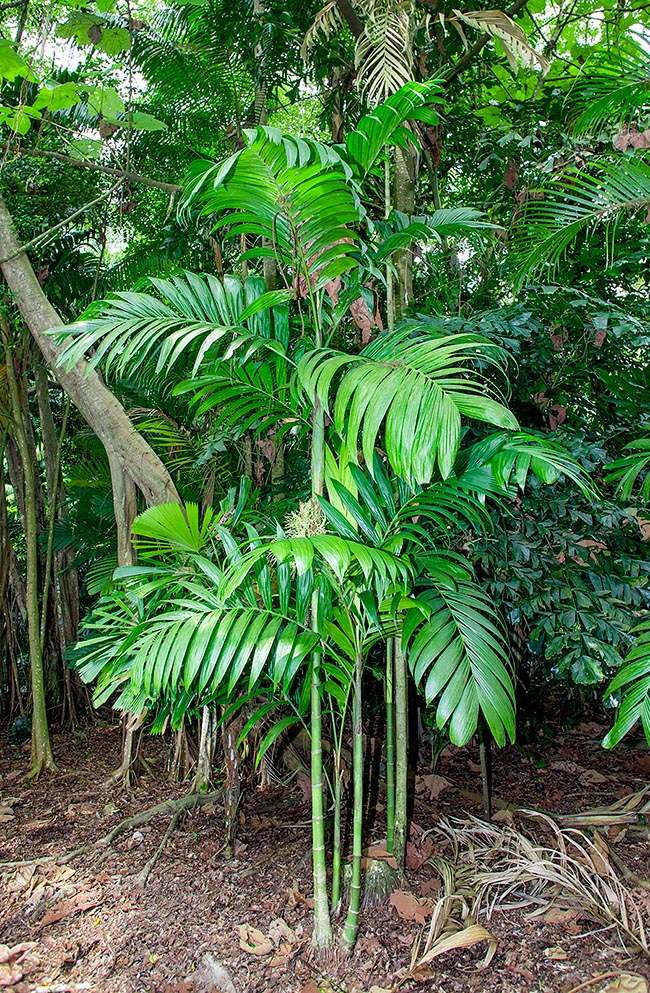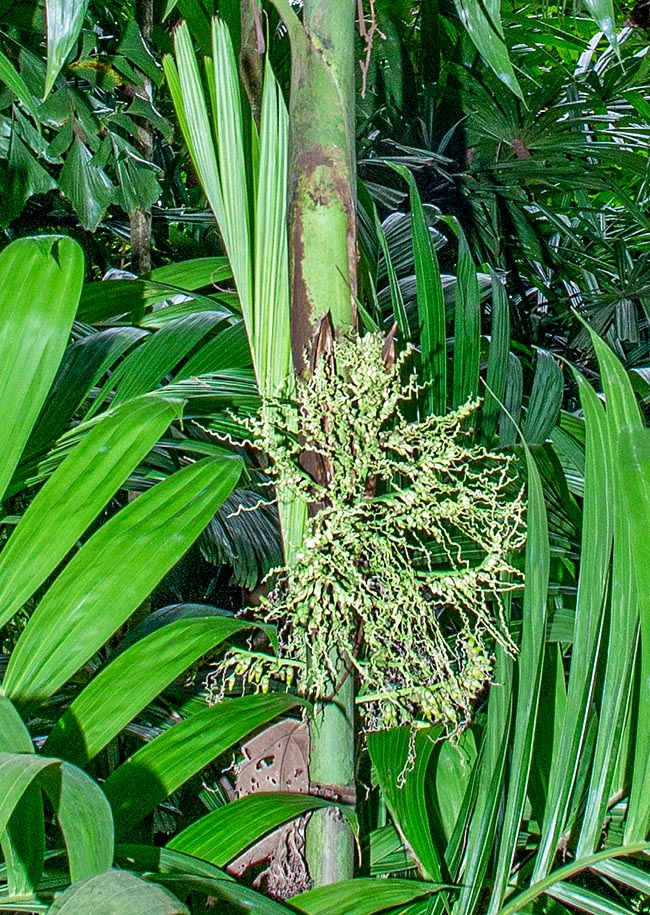Family : Arecaceae

Text © Alessandro Marini

English translation by Mario Beltramini

Native to the underwood of North-East Asian alluvial forest at low altitude, Areca triandra is a multi-stemmed monoecious species. The 7-5 cm broad fruits similar to the bamboo ones, can be 5 m tall © Giuseppe Mazza
Areca triandra Roxb. ex Buch.-Ham is found in India, Cambodia, South China, Laos, Malaysia, Burma, Philippines, Sumatra, Thailand and Vietnam, in the underwood of the alluvial forests at low altitudes, often in the margins of the vegetation.
The name of the genus Areca comes from “areca”, common name of these palms utilized in the Malabar coasts, region of South-West India.
The name of the species triandra comes from the Greek “treís”, three, and from “andrós”, male, referring to the male flower having three stamens.
Common names in English: Wild Areca Palm, Triandra Palm.
Areca triandra is a monoecious multi stemmed species with stems similar to the bamboo ones, that reach the height of 5 m and the thickness of 3-5 cm.
The stems are grey-green, run by evident rings that are the scars of the fallen leaves. At the base of every single stem generate aerial roots having the function of stabilizing the plant. The tufts are about 3 m broad, with young plants emerging continuously at the base of the bigger ones.
The leaves are pinnate, dark green, drooping, up to 1,8 m long, with big pinnulae of irregular size and with toothed extremities. The pinnulae reach even 1 m of length and are 3-5 cm broad, grooved by evident veins. The petiole is smooth and up to 20 cm long, bright green. It ends in a sheath of the same colour, swollen at the base, wrapping completely the trunk.
The ramified inflorescences emerge under the foliar sheaths and present up 30 green rachillae up to 15 cm long. The flowers are pale yellow cream, very perfumed, grouped in the classical triads (one female flower between two male).
The fruits are oval, up to 2,5 cm long, with one prominent extremity. They are green, then become orange and finally red when ripe. The plant blooms almost all the year and the fruits reach the maturation about 7,5 months after the pollination.
Areca triandra is a very sought for species thanks to its undoubted aesthetic qualities and is very diffused in cultivation in the tropical countries.

The up to 15 cm long inflorescences are very ramified and bear 2,5 cm ovoid fruits, green before, then orange and finally red when ripe. Seeds are often chewn with betel leaves or lime wedges for the medicinal virtues. Areca triandra has edible buds. Stems and leaves are locally used for huts building. Luckily this species is not endangered © Giuseppe Mazza
It is considered as one of the few species of the genus Areca able to stand lowest temperatures around zero. In the literature are reported cases of palms having survived at the exposition of -3 °C, even if occasionally and for very short times.
The young specimens prefer a position in total or partial shade, as the leaves burn easily if exposed to the sun. The adult specimens can stand a partial exposition to the sun if cultivated in very humid environments and with a great availability of water.
Areca triandra is much cultivated as an indoor plant due to its contained dimensions and for the low demand in terms of luminosity. In the closed spaces it is necessary to pay attention to the attacks of the red spider that can compromise the health of the leaves and even that of the whole plant.
It reproduces quite easily by seed that, if fresh, germinates in just one month. Otherwise, it can be reproduced vegetatively, removing the new small plants that are born at the base of the adult ones and that will take root more easily. Areca triandra has a fast growing rate.
This species is characterized by manifold uses in its origin countries.
The seed has mild digestive and cardio tonic stimulant properties and is amply utilized as bolus to chew, often mixed with leaves of Piper betle, other drugs, and usually with the lime.
In fact, the seeds of Areca triandra as well as those of Areca catechu, contain tannins and alkaloids and consequently do accelerate the heart rhythm and lower the sense of hunger. Moreover, they offer a good protection against the intestinal parasites.
The apical bud is edible, known as heart of palm or palm cabbage. The parts of the plant are utilized as animal feed. The stems are utilized as poles to build up the huts of the local populations, who also use the leaves as roof covers. Areca triandra is classified as “Least Concern” by the International Union for the Conservation of Nature (IUCN).
Synonyms: Areca polystachya (Miq.) H.Wendl.; Areca aliceae W.Hill ex F.Muell.; Areca borneensis Becc.; Areca nagensis Griff.; Areca triandra var. bancana Scheff.; Nenga nagensis (Griff.) Scheff.; Ptychosperma polystachyum Miq.
